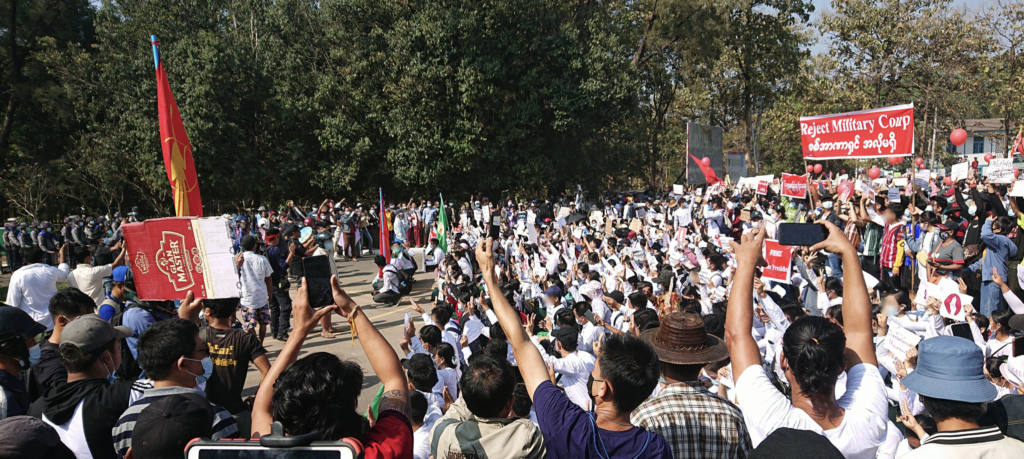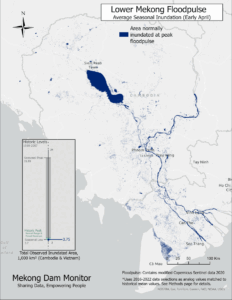The months of April and May 2023 marked a pivotal turning point in China-Myanmar relations, driven by the Chinese Special Envoy’s strategic diplomatic interventions. Through initiating peace talks with the northern Ethnic Armed Organizations (EAOs), marshaling business delegations for the revival of the China-Myanmar Economic Corridor (CMEC), and receiving high-level People’s Liberation Army (PLA) delegations in Naypyitaw, China has seemingly breathed new life into a relationship that had been frozen since Myanmar’s coup. However, this leads Myanmar watchers to a complex triad of questions: why has China decided to reengage, what are the hurdles and strategic visions shaping this engagement, and how will the State Administration Council (SAC) and National Unity Government (NUG) navigate this shifting landscape?
China’s proactive re-engagement with Myanmar can be attributed to the U.S. incorporating the Burma Act into the National Defense Authorization Act (NDAA)1Note: Michael Martin, “What the BURMA Act Does and Doesn’t Mean for U.S. Policy in Myanmar,” February 6, 2023, https://www.csis.org/analysis/what-burma-act-does-and-doesnt-mean-us-policy-myanmar., a move perceived by China as a direct provocation stemming from great power competition. The NDAA, already seen as anti-China, coupled with the passage of the Burma Act that China views as a security threat in its immediate vicinity uses Myanmar’s political crisis as a pretext to challenge China. This perceived provocation is further amplified by the NUG’s establishment of a representative office in Washington D.C., indicating U.S. support for the NUG and certain Ethnic Revolutionary Organizations (EROs), a development causing unease within China.
Additionally, border security and economic interests play a pivotal role. China perceives an unstable Myanmar as a potential vacuum that could jeopardize Chinese investments and provide the United States an opportunity to gain a foothold through its support of EROs and the NUG. Further, the rise in illicit business activities along the China-Myanmar and Thai-Myanmar borders, driven by a conflict-torn economy, is of significant concern for China.
Despite these substantial catalysts, Beijing’s renewed engagement with Naypyitaw is not without its challenges. In its dealings with Naypyitaw, Beijing has laid down fundamental principles. Unlike with past military regimes, China does not entirely back the SAC, instead advocating for an imminent election and subsequent transition to a civilian government. This stance has led to unease within the SAC leadership, especially concerning the insistence on holding elections.
Moreover, China currently shows reluctance in making new investments while recognizing that economic incentives could offer leverage over the SAC. This hesitation is influenced not only by nationwide instability but also the suspension of the Myitsone Dam project under the U Thein Sein administration2Note: OF-1, In a private meeting with official, April 30, 2023.. The unilateral decision-making process, which China perceived as disrespectful, caused the suspension to be viewed as both a financial loss and a severe breach of trust.
Going forward, China’s strategy revolves around two central elements. The first is stabilizing the border. Here, two key objectives come into focus: engaging with the EAOs to achieve a de facto ceasefire, which is critical for implementing the CMEC and cracking down on illicit activities, such as scam gangs and drug-related crimes. These activities go beyond the northeastern region to the southern Thai-Myanmar border, which has recently been the target of a joint Thai-Myanmar and Chinese crackdown3Note: Sebastian Strangio, “Thailand Cuts Power Supply to Criminal Hub After Request From Military Junta,” June 7, 2023, https://thediplomat.com/2023/06/thailand-cuts-power-supply-to-criminal-hub-after-request-from-military-junta/.. This crackdown was one of the top agenda items during the recent visit of the director of Chinese intelligence.
Secondly, revitalizing limited economic ties is essential not only from a security perspective — to prevent Myanmar from becoming a failed state — but also to maintain China’s position in Myanmar and counterbalance rapid engagement and potential investments from India. Ideologically this is vital, as economic growth and development are the core principles of China’s Global Development Initiative4Note: Ministry of Foreign Affairs, “Jointly Advancing the Global Development Initiative and Writing a New Chapter for Common Development,” August 22, 2022, Jointly Advancing the Global Development Initiative and Writing a New Chapter for Common Development (fmprc.gov.cn) , with Myanmar being a key stakeholder in realizing the Lancang-Mekong Cooperation (LMC), a showcase project for the initiative5Note: Chinese Central Media, “Wang Yi Gives an Interview to the Chinese Central Media on Attending the LMC Foreign Ministers’ Meeting and the G20 Foreign Ministers’ Meeting, Visiting Five Southeast Asian Countries, and Chairing Meetings of China-Vietnam and China-Cambodia Bilateral Mechanisms,” July 14, 2022, http://gr.china-embassy.gov.cn/eng/zgyw/202207/t20220716_10722418.htm. .
However, for such a strategy to be effective, it is crucial that the military government provide assurances and foster trust and extensive political support for substantial investments. SAC leaders are promoting a policy of enhanced engagement with China, including official endorsement of China’s new Global Security Initiative6Note: Ministry of Foreign Affairs, “Position of Myanmar towards the Global Security Initiative – GSI Proposed by H.E. Mr. Xi Jinping, President of the People’s Republic of China (28-4-2023)” (Ministry of Foreign Affairs, April 28, 2023), https://infosheet.org/node/4689.. Despite inherent power dynamics and potential concerns, Naypyitaw’s reliance on Beijing to bolster its economy and mitigate impending power and energy crises cannot be overstated.
Following the coup, the State Administrative Council (SAC) has derived considerable comfort from its re-engagement with China two years later. This move has effectively enforced a de facto ceasefire with northern factions7Note: OF-2, In a private meeting with official, May 13, 2023. and strengthened the SAC’s status as the de facto government internationally. However, to solidify these economic and political ties, the SAC needs to demonstrate a steadfast commitment to transition towards civilian rule, or at the very least drive the processes that bolster such a transition. Building trust with the leadership is crucial, although restoring trust levels to those seen before 2011 may require significant time. Given the current political milieu, Beijing is likely to proceed with caution in its interactions with the SAC’s leadership. Regardless, the existing engagement routes through the LMC and connections with the Yunnan administration offer the SAC a formidable starting point for engagement.
Nonetheless, the success of this strategy hinges not merely on diplomacy between Beijing and Naypyitaw, but also on the inclusion of a variety of stakeholders in the equation, such as the U.S., EROs, and the NUG. Without establishing a dialogue with the NUG and EROs, the pursuit of border security and safeguarding existing projects will remain persistently threatened, regardless of negotiations with northern groups. In arming the People’s Defense Force (PDF) and Local PDFs, the NUG possesses leverage to threaten existing projects. However, sustaining a threat is not strategically astute, especially given China’s potential to shape the final outcome of the current crisis.
The NUG has signaled its willingness to engage with China, and although multilevel communication exists, there has been no official engagement to date. Anti-Chinese sentiment in the immediate aftermath of the coup8Note: Rory Wallance, “Silent Chinese Companies Weigh Costs of Myanmar’s Growing Chaos,” Nikkei Asia, accessed June 30, 2023, https://asia.nikkei.com/Spotlight/Myanmar-Crisis/Silent-Chinese-companies-weigh-costs-of-Myanmar-s-growing-chaos. coupled with a western-leaning narrative harking back to the Cold War have complicated trust-building efforts with China9Note: OF-3, In a private meeting with official, May 14, 2023., notwithstanding any positive gestures. These actions often come across as hollow posturing without genuine intent.
A shared commitment to improving the situation in Myanmar could offer a rare platform for Sino-U.S. cooperation. The central question revolves around how effectively China and the U.S. can utilize their influence to bring all stakeholders to the negotiating table. Fundamentally, there must be political will for a peaceful resolution and de-escalation. The journey towards stability and peace in Myanmar is a complex maze and may not yet be ripe for mediation; however, it has reached a mutually painful stalemate that affects over 1.8 million people. Therefore, it is never too early to seek potential solutions.
Given the existing tensions between China and the U.S., cooperation might appear to be a lofty aspiration. Still, track two diplomacy for Myanmar remains a feasible option. China’s re-engagement, though limited and in its nascent stages, does not echo the comprehensive support seen in the early 2000s. Any interpretation of China fully backing the SAC requires a nuanced understanding to grasp the situation. While it is undeniable that relations between Beijing and Naypyitaw will strengthen over time, this should also be seen as an opportunity. No matter the efforts undertaken, without securing the hearts of the people and creating an environment of political stability, the successful realization of China’s strategic aspirations will continue to be a distant goal.
The views and opinions expressed here do not necessarily reflect the policies or positions of Stimson and PRIO.
Notes
- 1Note: Michael Martin, “What the BURMA Act Does and Doesn’t Mean for U.S. Policy in Myanmar,” February 6, 2023, https://www.csis.org/analysis/what-burma-act-does-and-doesnt-mean-us-policy-myanmar.
- 2Note: OF-1, In a private meeting with official, April 30, 2023.
- 3Note: Sebastian Strangio, “Thailand Cuts Power Supply to Criminal Hub After Request From Military Junta,” June 7, 2023, https://thediplomat.com/2023/06/thailand-cuts-power-supply-to-criminal-hub-after-request-from-military-junta/.
- 4Note: Ministry of Foreign Affairs, “Jointly Advancing the Global Development Initiative and Writing a New Chapter for Common Development,” August 22, 2022, Jointly Advancing the Global Development Initiative and Writing a New Chapter for Common Development (fmprc.gov.cn)
- 5Note: Chinese Central Media, “Wang Yi Gives an Interview to the Chinese Central Media on Attending the LMC Foreign Ministers’ Meeting and the G20 Foreign Ministers’ Meeting, Visiting Five Southeast Asian Countries, and Chairing Meetings of China-Vietnam and China-Cambodia Bilateral Mechanisms,” July 14, 2022, http://gr.china-embassy.gov.cn/eng/zgyw/202207/t20220716_10722418.htm.
- 6Note: Ministry of Foreign Affairs, “Position of Myanmar towards the Global Security Initiative – GSI Proposed by H.E. Mr. Xi Jinping, President of the People’s Republic of China (28-4-2023)” (Ministry of Foreign Affairs, April 28, 2023), https://infosheet.org/node/4689.
- 7Note: OF-2, In a private meeting with official, May 13, 2023.
- 8Note: Rory Wallance, “Silent Chinese Companies Weigh Costs of Myanmar’s Growing Chaos,” Nikkei Asia, accessed June 30, 2023, https://asia.nikkei.com/Spotlight/Myanmar-Crisis/Silent-Chinese-companies-weigh-costs-of-Myanmar-s-growing-chaos.
- 9Note: OF-3, In a private meeting with official, May 14, 2023.




